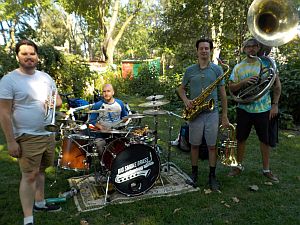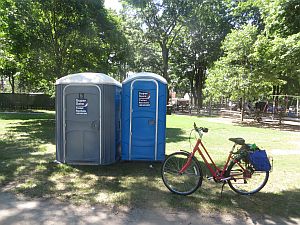Comments?
For the basics, see
- Website & Privacy Policies
- How To Get Involved
- The Role of the Park
Search options:
Department Site Map
Custodians:
Newsletter Summer - Fall 2020
This newsletter is put out by CELOS, the Centre for Local Research into Public Space. Since 2000, when this little organization began at Dufferin Grove Park, we’ve been doing what we call “theoretical and practical research” into what makes public spaces – like parks – more hospitable and more lively. We’ve been researching what works and what doesn’t, and we’ve documented a lot of what we’ve seen and done, in this newsletter and on our four websites.
Arts return to the park

Capoeira: The first evidence of fun returning to the park was the appearance in July of the Brazilian capoeira group led by Contramestre Sapo on the soccer field, to the rhythm of drums and a single-string instrument called the berimbau. Sapo says that capoeira is a combination of self-defense, acrobatics, dance, and music, created by slaves in Brazil (who were brought there, he said, in the sixteenth century), and expressive of that history. He has been leading this (distanced) group three days a week at the park, on Tues and Thurs at 6.30, Sunday at 6, and he emphasizes that this is an activity that works for all ages and abilities. His poster says: “Let’s ginga together, everyone welcome!”
Percussion: the Afro-Brazilian percussion group based in Toronto, Baque de Bamba, has begun having their Wednesday evening rehearsal at Dufferin Grove at 6 pm. “We perform Afro rhythms originating in the northeast of Brazil. The group consists of 25 - 30 people with varying degrees of music expertise, from beginners to professionals, and the group evolves and develops with each new participant.”
Theatre: The Theaturtle theatre company is bringing a play called Alphonse by Lebanese-Canadian playwright Wajdi Mouawad to Dufferin Grove Park. “Alphonse will be performed by local award-winning Toronto actors Kaleb Alexander and Alon Nashman and will be performed at the Cob House between August 27th through August 30th.” Alon is a park neighbour.
More information and more and more.
Surprises: a brass band came, and some Cuban drummers, and guitar groups at blanket picnics or the fire circle. There will hopefully be others – unscheduled but very nice.
The Dufferin Rink season
On August 12, Dufferin Rink shinny hockey player and journalist (and park neighbour) Ian Merringer sent a letter to City Councillor Ana Bailao: ''“I’m writing to ask you to save the upcoming skating season at Dufferin Grove Park by delaying construction for a few months. There is no counting the thousands of hours that west-enders enjoy on the Dufferin Grove skating and shinny pads every winter. For many, it’s the only way to be outside while getting exercise and seeing neighbours. Local lore tells of some children who will choose skating and hockey over video games.''
This year, the need for people to be active and social outside will be greater than ever if covid measures stymie indoor gatherings and activities. No one knows yet if hockey leagues will run, if the YMCA will be open, if restaurants will be serving, if schools will have gym classes. …..[T]hose sheets of ice could be critical for the mental health of thousands of people….. We’ve just heard the bidding period is closing August 21, with construction starting this fall/winter.
''It makes no sense to tear down the rinks just before a skating season, especially this one. You can preserve an invaluable neighbourhood facility for what could be an otherwise bleak winter.” Ian concludes his letter asking for construction to be postponed until March.''
The “northwest corner” redesign:
The arrival of covid and the restrictions to reduce its spread were of course an unexpected turn of events. The economic fallout is still on its way. The Globe’s architecture critic, Alex Bozikovic, wrote a column on Aug.1, with the heading “Parks need to make room for everyone.” He quoted from a recent Park People “Canadian City Park Report” calling for the city to “change some basics. Public washrooms. Seating. Protection from the elements.” Quoting Park People: “These are all things that make a park more comfortable for people who are relying on it” to live, “but they make the park more accessible to everyone.”
The $4.5 million expenditure on the rink redesign is not a step in this direction. The rink house was used as a broadly accessible community clubhouse for many years, but in 2018 the city changed the locks. The redesign image posted by the city appears to show a child care facility.
This redesign will allow the city to get more income by charging fees for seasonal and after-school child care, but it’s hard to see how the building can also accommodate park users of all ages. A pivot may be needed for this project – one that costs less and delivers a repaired clubhouse available at all times for everyone, and for whatever is coming.
Park maintenance:
The city’s response to Covid has resulted in a huge budget overrun, so in July, city council voted to adopt “workforce restraints” that would save $152 million by the end of the year. This means more spending on bylaw enforcement but less on seasonal staff, for example those who look after the park. (Many laid-off seasonal staff are staying afloat through the federal government’s CERB plan, for now.)
So: Dufferin Grove’s food programs are cancelled, the rink house washrooms remain locked, and although the grass is still cut, there’s less litter-picking. This is particularly true for the park’s community-built areas such as the sitting area by the bake ovens, the community and native-species gardens, the adventure playground sandpit and the cob courtyard. The restricted availability of the park washrooms, and the absence of park staff, have turned gardens, tree plantations and the borders of program areas (including the playground) into toilets.
Some persistent lobbying for playground kids by a park neighbour has resulted in the city putting two chemical toilets near the playground area. That may help some of the growing number of people living in the park in tents.
A return to the community park maintenance of the 1990s?
If the current municipal “workforce restraints” kind of budgeting is just the tip of the iceberg, park users may have to return to what we used to do in the 1990s -- working alongside the few remaining staff, and:
-- making sure the washrooms are open, clean and stocked, both in the field house and the rink house;
-- taking back charge of the sandpit, the cob cafe, playground maintenance and the ovens;
-- repairing broken picnic tables, setting up small arts events, monitoring the campfires, watering the trees during droughts,
-- collaborating in running the rink (if it ends up not being closed for a redesign) -- especially because indoor arenas may not be allowed to open much this winter.
The alternative is a park with locked or broken or unsanitary facilities unavailable for use. Alongside the covid challenges, that would be a double whammy.
Stewarding a park is hard work. But many people in this neighbourhood may find that time gets long when the covid-imposed restrictions mean their jobs are gone. Having some practical work that brings joy to the neighbourhood may help take away their sense of being superfluous. If any reader wants to get in touch about this: mail@celos.ca
The cob courtyard:
some seasonal repairs have begun (shingles replaced, plastering) and the cupboards need to be fixed. As of mid-August, the taps had still not been turned on, so no hand-washing has been possible.
Sports, games, and picnics:
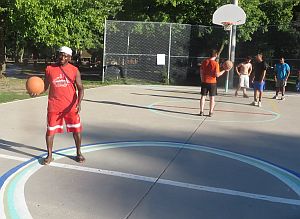
Desi Noel painted bright new lines on the basketball court
As government covid-related restrictions have gradually been lifted, the park is filling up with frisbee games, pick-up soccer, table tennis, volleyball, tai chi, yoga, domino players and skateboarders. Some of the skateboarding ramps were returned from Christie Pits on August 15, to spread the fun. And there are masses of basketball players. Park neighbour Desi Noel lobbied the city to repair a broken rim, and then bought paint and painted colourful lines on the court. Blanket picnics were all over the park as soon as they were allowed in June. As of mid-August the park picnic tables are still locked up inside the hockey rink pad.
Local covid update:
In mid-June, the city’s Public Health office published a neighbourhood-specific map showing the total of positive covid tests for each area. By June 14, the Dufferin Grove area had a total of 32 positive community tests and 35 positive long-term care tests, out of just under 10,000 area residents. That gave a total of 67, increased to 69 by the end of July.
On August 4, Public Health published a listing of how many of those people had been hospitalized at any point (4, in April); how many had been in an ICU (1), and how many on a ventilator (1 – the same person, also in April, now listed as recovered).
There were, however, 10 deaths early on. The first one was a returned traveler on March 14, in her 70s. The other 9 deaths came within one 16-day onrush, between April 5 and April 21. All were long-term care residents, presumably at New Horizons Tower: three people in their 80s, and six in their 90s.
By mid-August, the Public Health map showed a total of 5 more positive covid tests of Dufferin Grove residents, but no more hospitalizations.
The community gardens:
Skylar Hill-Jackson is the lead for the Dufferin Grove Park Garden Club Cooperative. She says this year there have more people helping out than ever. Some of the planting was late, because permission to plant was not given until May 27. But then the green thumbs got to work. A call went out to the neighbourhood for perennial plants and lots were donated. In late July the park’s loyal garden centre friend, Lou Micelli (across the street at the mall) gave Skylar a lot of his best leftover plants. Between the hot sunny summer and Joel Berg’s almost daily watering sessions, the gardens have become a neighbourhood beauty spot for evening strolls. Garden helper Michele Niffeler has been taking kids there to learn about plants. Garden helper Rebeccca Catching turned her new gardening knowledge into a landscaping job. To join in: the sessions are Tuesdays 6 to 8pm, Wednesdays and Fridays 9 to 11a.m., and usually one pop-up as needed. Come by and find out more.
Tents:
All of the people living in the park (8 tents as of mid-August) are hoping to be housed in a hotel or an apartment before it gets cold. Right across from the park at 137 Havelock is a white building, privately owned and recently renovated, that has a city boarding house license and contains 12 rooms, nine with their own bathrooms. These rooms have been empty for about 20 years. Wouldn’t it be good if the city could buy them and make them available?
The encampment:
For about two weeks in July there was a large encampment of protesters at the park. They called themselves the Afro-Indigenous Rising Collective, and said they stood for police abolition. CELOS researcher Mayssan Shuja Uddin wrote this after interviewing one of the organizers: “The collective are attempting to create an intentional protest community within a non-hierarchical structure. Action is agreed upon collectively, caring for one another’s needs is part of keeping that society going. In occupying Dufferin Grove Park, the group erected tents, served free food, questioned the sense in closing the washrooms to the public after 5 pm (by occupying the space and preventing it from being closed), and stood their ground in the city’s first eviction attempt. They sent a long letter to Parks and Rec general manager Janie Romoff, asking for a fair and meaningful discussion of how their presence at the park could continue.”
But this did not happen: on July 29, about 20 police and more than 40 city security staff (wearing bulletproof vests) evicted the protesters from the park, as many parks management staff and also park neighbours watched.
Flashback: A snapshot of police and community relations in Dufferin Grove Park: 2003
One evening in May 2003, three police officers were questioning a young Jamaican man who had been walking along the sidewalk near the rink house, talking on a cell phone. A park neighbour (this newsletter’s editor), picking up litter nearby, wrote a letter the next day to the police chief, then Julian Fantino, about what she saw. She wrote that it seemed to her the officers were just randomly "fishing" when they questioned this young man. She quoted one of the police officers, who had told her, as she stood there watching, to "go hug a tree." The letter to the chief resulted in a request for the park neighbour to come to Fourteen Division and be interviewed by four officers. This interview, which was taped, lasted over an hour and resulted in a formal police report complete with cover page, index and appendices. In defense of the apparently random police questioning of the young man, the report cited (1) a statistical increase in car thefts in Fourteen Division, (2) the fact that car thieves tend to use cell phones, and (3) that as they observed the young man, he changed direction from westbound to eastbound (actually walking back up the sidewalk toward the police).
The report also suggested that anyone who, like the park neighbour, stops to observe police questioning someone could be charged with obstructing police, a charge carrying a possible jail sentence of two years less a day.
This was another unfortunate episode in the park’s regrettably lengthy history of unhelpful relations with Fourteen Division. (There’s quite a lot more detail about the police and park users on the dufferinpark.ca website.) Park friends’ attempts at building a working relationship first ran into trouble ten years earlier, when staff and neighbours wanted to change the threatening, uncivil atmosphere at the rink house in winter. The police told the park supervisor then that he couldn't count on them to help park staff enforce the city's own public-space by-laws. As a result the city's park supervisor had to make a contract with Intelligarde, a private security company, for one winter, until the rink problems began to resolve.
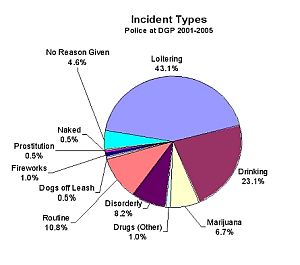
police stops at the park, 2001 to 2005
Over the years, attempts to meet with individual community police officers, to explain what was needed at the park, were largely ignored. Park staff and neighbours can remember the frustration of waiting at the rink house at some of the scheduled meeting times and having the officers never arrive, nor even call to cancel. When the “Community Action Policing” (CAP) program gave police some extra millions in 2002 to give closer attention to public space, the result was mainly more random questioning of youth who were sitting at picnic tables. Park friends made a freedom of information inquiry. It showed that 58.5% of police reasons for such questioning (carding) were for “loitering,” “routine” and “no reason given.”
A postscript to the 2003 encounter: The young Jamaican man who was being questioned walked away - as he evidently knew he had the right to do. After he had gone, the litter-picking neighbour stayed and argued with the police about their "fishing." They maintained that she was ignorant of the real dangers of living in this area of Toronto and of being in the park, and that if she had any opinions about their procedures she could keep them to herself or get them off her chest at a meeting. As this tedious and certainly fruitless argument was still going on, the young man came walking back. He went up to the neighbour, shook her hand - a risky gesture in that situation - and thanked her, and then left again. The neighbour admired his courage and felt ashamed at the history that prompted his handshake.
Subsequent to this encounter, there was an offer from a Dufferin Rink shinny hockey player who was also a criminal lawyer and who had just written an article about the Toronto police use of the “obstructing police” charge. He helpfully ran a workshop for park friends and park staff on how to avoid such a charge. For some years after, the park staff and some park neighbours made it a practice, when police were questioning someone or making an arrest at the park, to stand nearby – eyes on the park! – but respectfully keeping a distance and never interfering. The laws of this country do not forbid that, and the helpful lawyer said that he would defend any observer who was charged with obstruction under those conditions, pro bono. It was never necessary.
The farmers’ market
Farmers’ markets are starting up again across the city, but with rules that make it much harder to shop there than going to a supermarket. Dufferin Grove market manager Anne Freeman decided the market should remain only virtual, with timed pickup of pre-ordered and prepaid boxes in the parking lot of St.Anne’s Church. She wrote: “In June, Toronto Public Health issued a 6 page directive to farmers’ market organizers outlining the conditions which would have to be met in order to resume operations in-person. Markets must be fenced or taped off so there is a single entry and exit point. Within the enclosure, there can be no more than one person per four square metres at any time. No seating, communal tables or eating is allowed within the market area. ….Pedestrian traffic within the market area is to proceed in one direction only….The speed at which farmers and vendors could sell their products when the number of people in the market area is so limited, when lineups have to include physical distance, and transactions have to proceed so carefully would hugely reduce their earnings for the time invested…. Many people are not comfortable shopping in person right now, and have expressed their gratitude for our delivery option.” A summer employment grant has allowed the hiring of several helpers including a data entry clerk. The extra staff necessary to do a market under these conditions mean that farmers have to pay more for their table spots. Everything that was easy becomes complicated!
For those people who still prefer to see the produce for themselves and pick out what they want – and to see the farmers, even if chatting is discouraged – there are a number of nearby in-person markets, overflowing with seasonal produce: Sorauren on Mondays, Trinity on Tuesdays, and Wychwood on Saturdays. All the markets have accommodations in place for people who have disabilities, even if their websites don’t say so.
The community ovens:
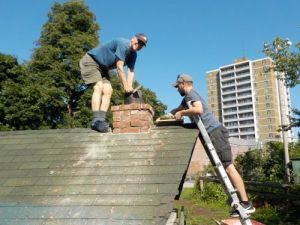
Dale and Cam fixing the chimney
It’s full-on harvest season at the farmers’ markets. Over the years, park users have often oven-dried their market tomatoes and roasted their corn in the park ovens, to preserve them for the wintertime. A letter went to the park supervisor asking for permission to do that and also to make some food – pita with hummus, corn in the husk – for the blanket picnics, distanced and with no need for plates. The supervisor said she will try to set up a meeting with public health staff to talk about the idea but “As you can imagine this is a very challenging and busy time for TPH and their time is limited.” So progress is still stalled, as in so many areas. One piece of good news: in early August the bigger oven’s crumbling chimney was rebuilt, as a favour, by our bake-oven friend Dale Howey and his son Cam. So the oven is ready to go.
Editor: Jutta Mason
Illustrations: Jane LowBeer
www. dufferinpark.ca, celos.ca, cityrinks.ca, publicbakeovens.ca




 Printer friendly version
Printer friendly version
